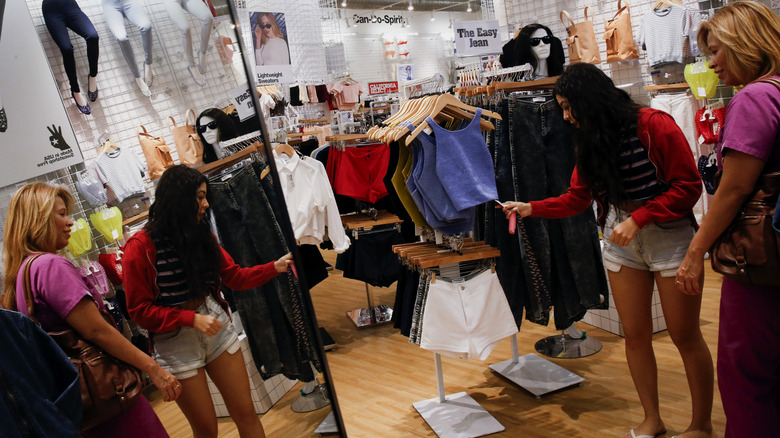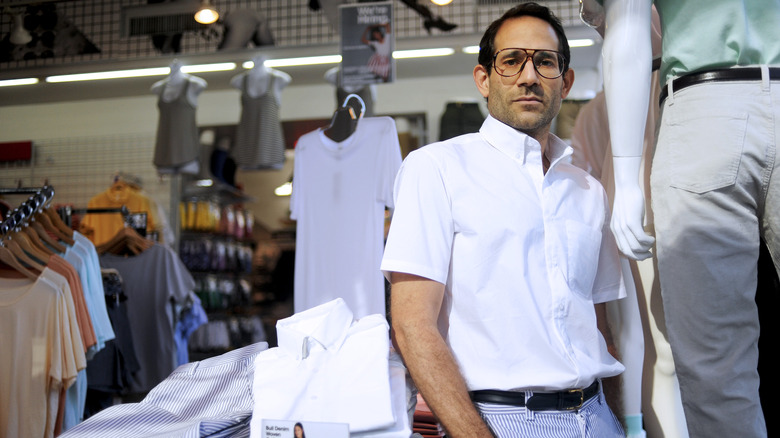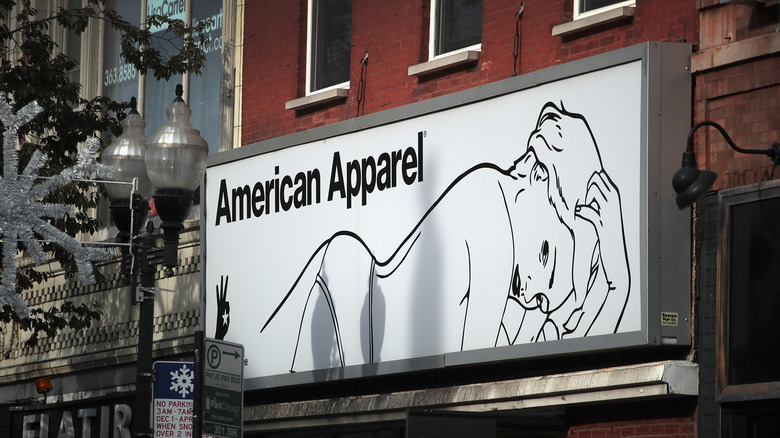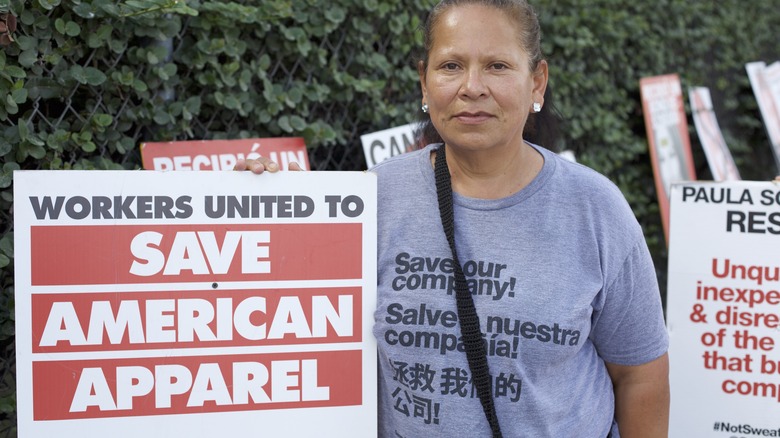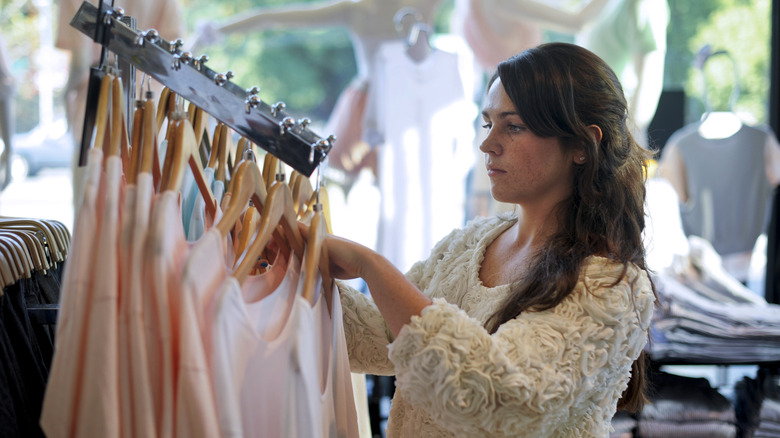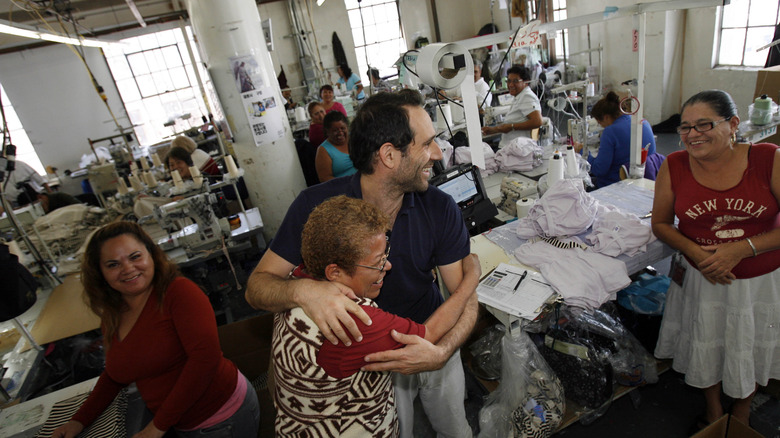Whatever Happened To American Apparel?
American Apparel was once one of the "it" brands of the early to mid-2000s. Curated for millennials, the brand introduced quality pieces that were seen all over Tumblr. While it seems like a distant memory, at one point it had over 250 stores and brought in over $630 million in yearly revenue. While we all loved the interlock miniskirts and the disco pants, that was not enough to keep things going.
The brand is still around today, but it's not what it used to be. American Apparel started in 1989 and has gone through major changes. In 2017, it was bought by Canadian retailer Gildan Activewear and has moved away from its brick-and-mortar roots. The retail powerhouse is now online only and has made a complete rebrand of the store we all knew and loved. While it's been a long journey, American Apparel has been through many ups and downs that ultimately led them from success to relative obscurity.
How American Apparel began
Everything started with Dov Charney. In 1989, the 20-year-old wanted to create a place to sell T-shirts while he was in college. After he dropped out of Tufts University, he decided to pursue what we now know as American Apparel full-time. For the next 10 years, he would work on building his brand. He moved to California in 1997, where his brand finally started to take off. The company became well known as a wholesale business that paid its garment makers high wages, a practice that was not common at the time.
In 2003, Charney opened the first American Apparel retail store in Los Angeles, California. The store sold fashion staples for women, men, and children, and was known as an affordable option for all. By 2007, it had expanded to over 147 stores in 11 countries, creating what once looked like a brand that would only continue to grow.
The many controversies of American Apparel
While American Apparel's rise to mainstream success would make it a household name, it did not come without a slew of controversies. According to The Week, the firestorm began in 2005 when Charney was accused by two employees of using "crude language and gestures" while on the job. He was alleged to have been inappropriate with the women of the company, including conducting job interviews in his underwear, as well as handing out a sex toy to one employee. Charney denied the allegations, stating, "Their lawsuits are a false attempt to extort money from my company and exploit my transparent persona."
In another instance, the company's ads depicted a topless model who appeared to be underage. While they ended up taking the ad down, they also stated the model was actually 23. U.K. operations manager Brent Chase said, "People are made uncomfortable by this, and it occasionally causes an unfortunate reaction." However, his claim that "Our models are real girls who are often employees or friends of the company" were refuted, as many professional models represented by modeling agencies worked for the brand.
In 2009, American Apparel laid off 1,500 workers connected to an investigation that the brand employed undocumented immigrants in its Los Angeles factory. Charney said he would rehire the workers when "you are able to get your immigration papers in order." These are just a few of the issues the company faced, but nothing could prepare them for what was to come.
American Apparel's bankruptcy
In 2014, Dov Charney was fired after he was alleged to have engaged in inappropriate behavior with staff as well as misusing funds. Regarding the former allegations, he said to The Guardian in 2017, "Sleeping with people you work with is UNAVOIDABLE!," adding, "I'll say this, I never had a romantic relationship with a factory worker. Ever! It wouldn't be possible! But a creative equal? Yeah! And if anything, I'll tell you, I don't know who was the predator –- you know what I'm saying?" Not exactly helping his case.
He then filed a defamation suit against the company in 2015, and his mega-brand was taken over by new CEO Paula Schneider. Schneider had to deal with the massive debt that Charney had accrued due to over-expansion. In order to get things back on track, she filed for Chapter 11 bankruptcy in 2015; the company hadn't been profitable since 2009. Under the new leadership, American Apparel had to cut overtime for factory workers, as well as shut down 40 underperforming stores. During this time, Schneider had plans to rework American apparel to make it easier to shop and a profitable business overall.
Despite Schneider's best efforts, the company filed for bankruptcy for a second time in 2016. To save the dying company, it was bought by Gildan Activewear Inc. for $88 million. Under the new deal, Gildan would acquire all of the intellectual property of the store so that shoppers could still enjoy the store online.
The rebrand of American Apparel
American Apparel looked different under Gildan Activewear Inc. The brand, known to be USA-based, now gave customers the option to also buy its items made in various places around the world. "Both are sweatshop free. Identical in quality. Different in price," the brand declared on its website (via Glossy). The "globally made" clothing was significantly cheaper than the USA-made clothes, causing the company to focus on manufacturing out of the country, in a warehouse in Honduras.
In 2020, the company decided to move its e-commerce brand to Amazon. Under this new system, shoppers can look around its commerce website before completing their actual purchase through Amazon. While they claimed that the idea of globally sourced clothing does not equate to worse quality, customers have noticed a decline in material. "This shirt doesn't even resemble a genuine American Apparel shirt," a reviewer wrote in 2020. "The fit is large, the cut is generic and not at all like an AA fit, the material is heavy and thick, even the color is off from my other AA shirts." Another commenter remarked that the "quality of this new shirt is so low, there are threads hanging out all over the seams" (via Glossy).
The launch of Los Angeles Apparel
Believe it or not, being fired from America Apparel was not the end of Dov Charney's business endeavors. In 2016, it was announced that the former CEO would create a new brand known as Los Angeles Apparel. For this company, he would have a new partnership with TSC Apparel for distribution. "We were one of the original distributors of American Apparel," Bob Winget, president of TSC Apparel, told Apparel News. "We dealt with that company for 20 years, and we had a lot of success with them."
According to KPCC, the brand's warehouse is located in Los Angeles with about 300 workers at the time of its inception. Many of Charney's workers were previously employed at American Apparel and even loaned him money to get the business off of the ground. "All my wealth was lost. All I had was my running shoes. I had nothing, so we needed money to get things going," Charney told the news outlet.
The company has become successful in its own right. According to a company spokesperson, the new brand was shipping about $500,000 in clothes each week and has continued to be a reliable wholesale option for businesses. As for Charney, he filed for bankruptcy in 2022, and as of 2023, was tapped by Ye (for whom he designed the controversial "White Lives Matter" T-shirt) for the rapper's brand, Yeezy.
